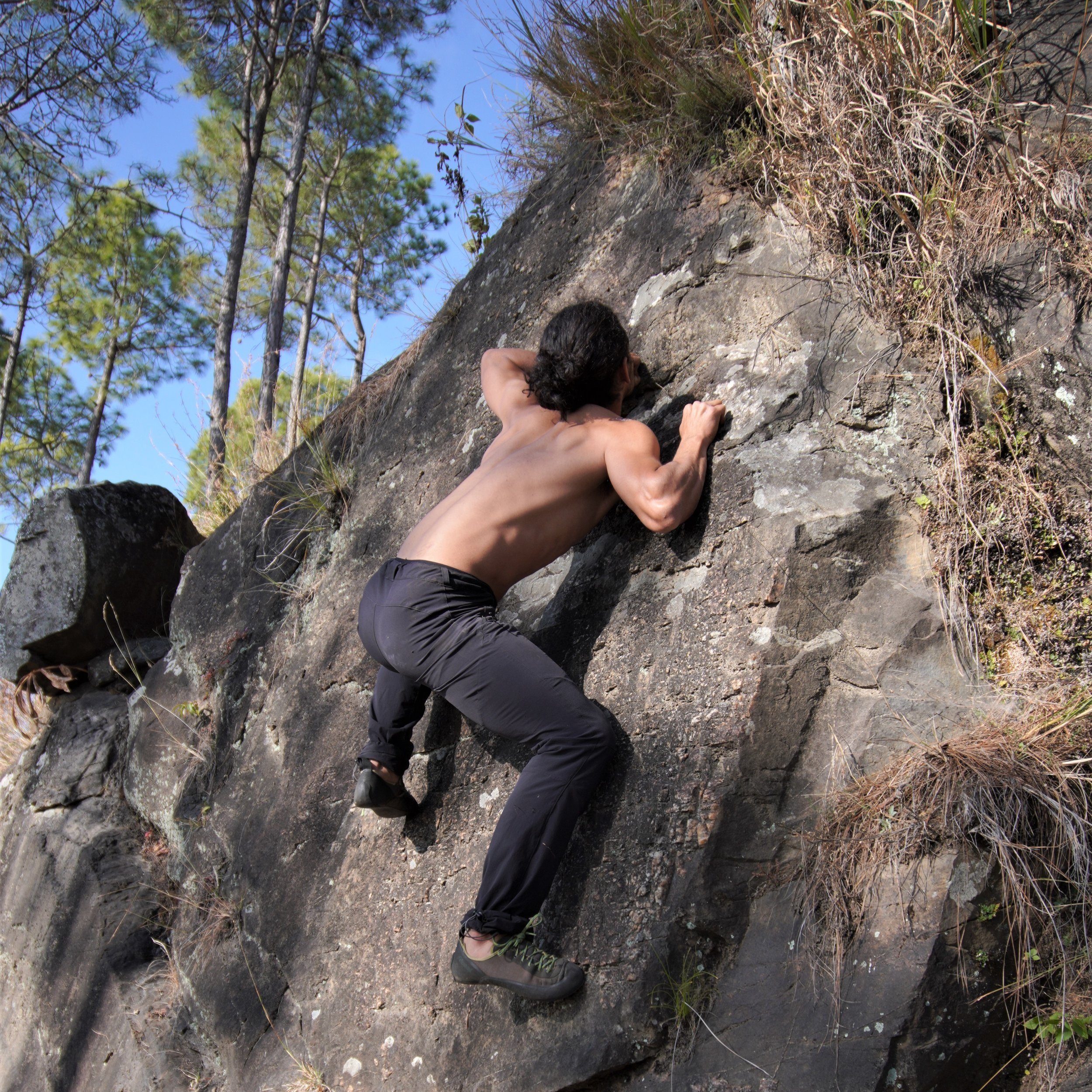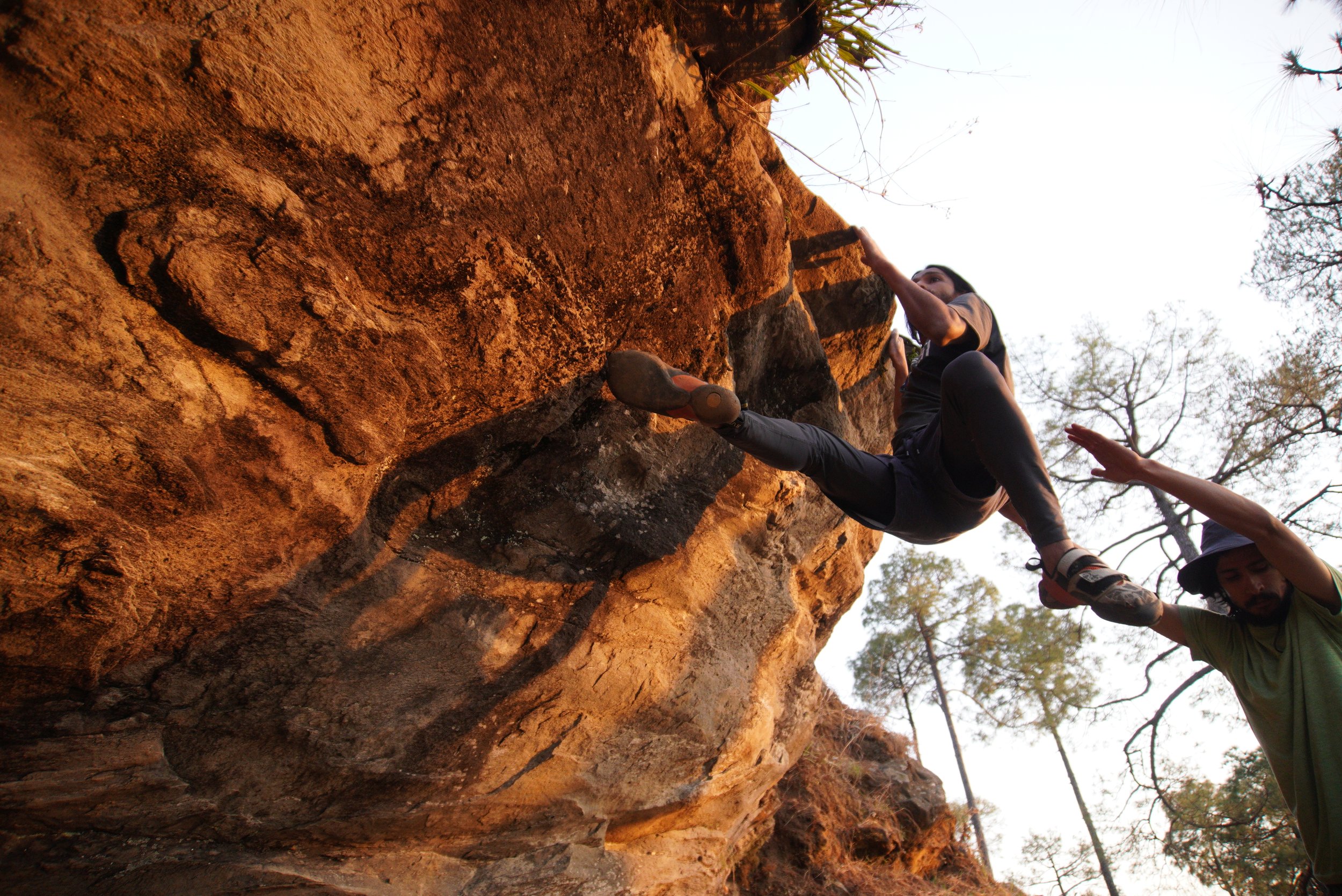Local Climbing Community in Almora, India Produces Its First Guidebook
GCI connected with author Siddhartha Chattopadhyay to discuss the process and motivation behind developing a guidebook for this new climbing area
By Robert Kyte | February 2023
Guidebook cover images
Guidebook author and founder of RockTrailSleep, Siddhartha Chattopadhyay. Credit: Vanshika Vohra
Almora, a region in the Himalayan foothills, is growing to become a new climbing destination thanks to the work of Siddhartha Chattopadhyay and the local climbing community of RockTrailSleep. We connected with RTS last year to learn about their philosophy of teaching climbing not just as recreation, but as a way of life centered around the meditative, reflective, and community-oriented nature of the sport. Since our initial spotlight, RTS has continued their work to develop climbing in the Almora area by searching for potential crags, establishing new routes, hosting affordable climbing clinics, and founding a RockTrailSleep base, lounge, and shop.
Now, Chattopadhyay has published the area’s first climbing guidebook: The Essential Guide to Climbing in the Almora Area, Volume 1. We caught up with him to learn about this huge milestone for the Almora climbing community, as well as the continued development of climbing in the area and the growth of RTS.
GCI: How long has an active climbing community in Almora existed?
Siddhartha Chattopadhyay: The community has only been active for the last four years. Prior to this, there was no climbing that I am aware of.
When did the potential benefits of creating a guidebook first become clear to you, and when did you decide to take up the mantle? Was anyone else involved?
I have always enjoyed documenting and journaling, and so the thought of working on a guidebook came very naturally to me. I realized the importance of having a guide early on when I first laid my hands on the guide to climbing in and around Delhi. It was fascinating to see that book, and I remember using it when I lived in the Delhi area. Today, the area seems to have come a long way, and it is only growing. As such, I believe a guide is absolutely foundational to the overall development of climbing in any particular area.
As soon as I started climbing back home around 2019, I started logging all of my climbs. And the more I worked on it, the clearer its purpose became. As far as the guidebook itself is concerned, I was entirely on my own.
Vikrant Bandari on Crimp Eater, V3. Photo: Pradyuman Rawat
Can you describe the contents of the guidebook? How did you gather photos? What sorts of climbs make up the book (sport, boulders, trad, etc)?
The guide consists of a preface attributing to my experience as a child growing up in Almora. In addition to this, there are two forewords written by Yadu Bagheria [co-founder of BoulderBox, a climbing gym in Delhi] and Prerna Dangi [professional climber, mountaineer, and GCI Ambassador]. Yadu has recently authored a climbing guide to Sethan, [India], and he visited Almora for a short climbing trip. Prerna was also here and climbed a bit in one of the areas. Because of this, I thought it would be relevant for them to contribute to the guide and share their experiences.
In the beginning, I took most of the photos. Later on, I asked Pradyuman to see if he would be interested. He showed up and took some great shots. It was a lot of work going back and forth but certainly worth it.
The climbs mostly consist of top-rope and bouldering, although there’s a lot of potential for sport and trad. There are also a few faces that I would like to bolt and put up some sports lines. I believe this is an absolute must for any grassroots level development.
This guidebook largely excludes grades. Can you talk about the thought process behind this decision?
I have briefly covered grades in the book to explain what they are and how we use them. That said, I didn't want to focus on them that much. I thought that it was a better idea to just have an overall view of the problems we have climbed. This was from the perspective that people should be able to climb and enjoy it for what it is, particularly those who are just getting started.
However, there are certain grades that I have included purposefully because they may have an appeal to more experienced climbers.
Can you describe the process of developing a climbing guidebook from scratch? What were the challenges of this project?
It is always easy to start a project, but bringing it to fruition is what really matters. The biggest challenge was when I realized that I wanted to publish a physical copy. Bringing all the resources together and making sure I had enough to get it published was all a bit daunting in the beginning. Not having a job didn’t help either. The fact that I was simply possessed kept me going until the end.
I also had to work with a designer, and there was a lot of learning that took place during the whole process. We went back and forth on many revisions. This was my first time bringing a book together, and since I had other commitments, finding the balance and motivation was also quite challenging.
I came to a standstill and didn’t quite know what to do with it for a long time. It was like a big boulder problem that I’d run into every now and then. In the end, I just had to be patient and work on it as and when I could. Eventually, it all worked out.
Siddhartha Chattopadhyay topping out on Samsara at the Kasar Devi Temple Ridge Area. Photo: Pradyuman Rawat
Other than the obvious route-finding benefits, how do you foresee an official guidebook contributing to the further development of climbing in the Almora area?
Aside from having climbers experience the climbs here, I’d like the guide to establish itself as an authority. I want these areas to be protected and that can only happen when the local government starts to recognize this as a sport. As I mentioned earlier, the guide includes rock faces that are yet to be climbed. There is huge potential for developing these crags and putting up all kinds of lines on them.
In addition to this, I hope the guide will act as a catalyst for a new movement within the local youth. Aside from inviting existing climbers from all across the world, it will also be a tool to introduce people to this beautiful sport.
Why should climbers travel to Almora specifically? What makes the climbing experience here unique?
What makes Almora unique is the way it’s positioned. It acts as a gateway to the upper reaches of the Himalayas. You could be climbing in Almora with a backdrop of some of the biggest mountains in the world. This view is unique, rare, and world-class.
Vikrant Bandari climbing the east face of Hunter's Rock in Binsar. Credit: Siddhartha Chattopadhyay
Can you provide a quick update on the development of RockTrailSleep?
We now have a functioning physical office from where we are going to operate. We will continue doing what we always have, which is to teach and develop. And slowly with time and patience, we will expand the scope of our development. Which means that we will move to other geographies and continue building upon the existing work.
This guidebook is titled ‘Volume 1’. Do you have plans to develop an additional volume in the future? What needs to take place in order to further develop climbing in Almora? How can the climbing community assist in this effort?
Yes, more editions and volumes will come out in the future. We need to step up the game, get more people involved, and put up more lines. The community can assist in terms of sharing skills and gear donations.
The Global Climbing Initiative is in need of donations to send gear from the US to Almora.
Chattopadhyay is seeking a publisher to make the guidebook available worldwide. If you are interested in purchasing the guidebook, you can connect with Chattopadhyay directly via Instagram @peacefulending, or via email: siddharthachatterji@live.com. RockTrailSleep is stoked to welcome visitors to Almora and happy to answer any questions.






